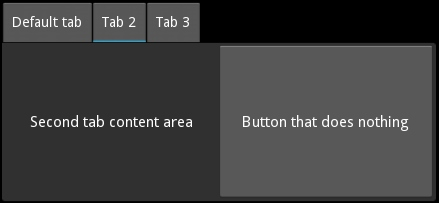基维TabbedPanel的动态控制
基维TabbedPanel的动态控制
提问于 2018-10-17 00:21:33
我想让TabbedPannel在一开始就看不见,
然后,当某些任务完成时,我想在之后显示选项卡。

from kivy.app import App
from kivy.uix.tabbedpanel import TabbedPanel
from kivy.lang import Builder
Builder.load_string("""
<Test>:
size_hint: .5, .5
pos_hint: {'center_x': .5, 'center_y': .5}
do_default_tab: False
TabbedPanelItem:
text: 'first tab'
Label:
text: 'First tab content area'
TabbedPanelItem:
text: 'tab2'
BoxLayout:
Label:
text: 'Second tab content area'
Button:
text: 'Button that does nothing'
TabbedPanelItem:
text: 'tab3'
RstDocument:
text:
'\\n'.join(("Hello world", "-----------",
"You are in the third tab."))
""")
class Test(TabbedPanel):
pass
class TabbedPanelApp(App):
def build(self):
return Test()
if __name__ == '__main__':
TabbedPanelApp().run()上面的代码来自Kivy文件。
我想做的是
- 隐藏选项卡(还防止移动选项卡)
- 当完成某些操作时,从屏幕外部滑动选项卡。
有什么想法吗?
回答 1
Stack Overflow用户
回答已采纳
发布于 2018-10-17 06:02:27
听起来像是一个有趣的小挑战,下面是我想出的:
'''
TabbedPanel
============
Test of the widget TabbedPanel.
'''
from kivy.animation import Animation
from kivy.app import App
from kivy.clock import Clock
from kivy.uix.floatlayout import FloatLayout
from kivy.uix.scrollview import ScrollView
from kivy.uix.tabbedpanel import TabbedPanel, TabbedPanelStrip
from kivy.lang import Builder
class Test(TabbedPanel):
def __init__(self, **kwargs):
super(Test, self).__init__(**kwargs)
self.initialTabHeight = None
self.myTabsList = None
self.start_top = None
self.tabs_showing = True
# this TabbedPanelStrip will be a copy of the real one (self._tab_strip)
self.tmp_tab_strip = TabbedPanelStrip(
tabbed_panel=self,
rows=1, size_hint=(None, None),
height=self.tab_height, width=self.tab_width)
# this is the movable Widget that contains the tabs
self.movable_tab_strip = ScrollView(size_hint=(None, None), height=self.tab_height)
# These value are needed to set the width of self.movable_tab_strip, but
# they aren't always available when self.first is called below
self._tab_strip.bind(width=self.tab_strip_width_changed)
self.bind(width=self.panel_width_changed)
Clock.schedule_once(self.first)
def tab_strip_width_changed(self, instance, new_width):
self.movable_tab_strip.width = min(self.tmp_tab_strip.width, self.width)
def panel_width_changed(self, instance, new_width):
self.movable_tab_strip.width = min(self.tmp_tab_strip.width, self.width)
def first(self, *args):
# show tab2, so that the Button will be available
self.switch_to(self.parent.ids.tab2)
# save some info
self.initialTabHeight = self.tab_height
self.myTabsList = self.tab_list.copy()
tsw = 0
for tab in self.myTabsList:
if tab.size_hint_x:
tsw += 100
else:
tsw += tab.width
self.tmp_tab_strip.width = tsw
self.movable_tab_strip.add_widget(self.tmp_tab_strip)
# actually remove the tabs
self.do_clear_widgets()
def do_clear_widgets(self, *args):
# eliminate the tabs and populate the moveable_tab_strip
#self.movable_tab_strip.width = min(self.tmp_tab_strip.width, self.width)
self.tab_height = 0
self.clear_tabs()
for tab in reversed(self.myTabsList):
self.tmp_tab_strip.add_widget(tab)
self.tabs_showing = False
def do_progress(self, animation, widget, progression):
# grow the tab height when the moveable_tab_strip impinges on the TabbedPanel
# this has the effect of appearing to shrink the TappedPanel to the size it will have when the tabs are replaced
if self.start_top > self.movable_tab_strip.y:
self.tab_height = self.start_top - self.movable_tab_strip.y
def do_replace_tabs(self, *args):
# replace the moveable_tab_trip with the actual tabs
self.tmp_tab_strip.clear_widgets()
for tab in reversed(self.myTabsList):
self.add_widget(tab)
self.tab_height = self.initialTabHeight
self.parent.remove_widget(self.movable_tab_strip)
def do_tab_toggle(self, *args):
if self.tabs_showing:
self.do_clear_widgets()
else:
self.anim = Animation(pos=(self.x+2, self.y + self.height - self.movable_tab_strip.height))
self.movable_tab_strip.pos = (self.x + 2, App.get_running_app().root_window.height)
self.start_top = self.top
self.parent.add_widget(self.movable_tab_strip)
self.anim.bind(on_progress=self.do_progress)
self.anim.bind(on_complete=self.do_replace_tabs)
self.anim.start(self.movable_tab_strip)
self.tabs_showing = True
class MyLayout(FloatLayout):
pass
theRoot = Builder.load_string("""
MyLayout:
Test:
id: thePanel
size_hint: .5, .5
pos_hint: {'center_x': .5, 'center_y': .5}
do_default_tab: False
TabbedPanelItem:
text: 'first tab'
Label:
id: theLabel
text: 'First tab content area'
TabbedPanelItem:
id: tab2
text: 'tab2'
BoxLayout:
Label:
text: 'Second tab content area'
Button:
text: 'Button that does something'
on_press: thePanel.do_tab_toggle()
TabbedPanelItem:
id: tab3
text: 'tab3'
RstDocument:
text:
'\\n'.join(("Hello world", "-----------",
"You are in the third tab."))
TabbedPanelItem:
text: 'tab4'
Label:
text: 'This is Tab4'
TabbedPanelItem:
id:tab5
text: 'tab5'
Label:
text: 'This is Tab5'
""")
class TabbedPanelApp(App):
def build(self):
return theRoot
if __name__ == '__main__':
TabbedPanelApp().run()其想法是创建一个“可移动的”选项卡条,用TabbedPanel中的实际选项卡填充它,然后将该选项卡条动画化。我更改了kv语言字符串,将整个程序放在一个FloatLayout中(我认为这使Animation变得更容易)。以前什么都不做的Button现在切换选项卡。在do_tab_toggle()方法中,我将可移动选项卡条的x位置设置为TabbedPanel + 2的x位置。这2是一个模糊因子,我无法确定为什么需要它,对于其他TabbedPanel实例,它可能有所不同。do_tab_toggle()的“删除”部分也可以是动画的,但留给读者的练习是:-)
其他选项是使用clear_tabs()方法清除选项卡,或者动画TabbedPanel的tab_height属性(将高度设置为零以隐藏选项卡)。
编辑:添加了几个绑定来捕获调用first方法时不可靠的数据。
页面原文内容由Stack Overflow提供。腾讯云小微IT领域专用引擎提供翻译支持
原文链接:
https://stackoverflow.com/questions/52845657
复制相关文章
相似问题

